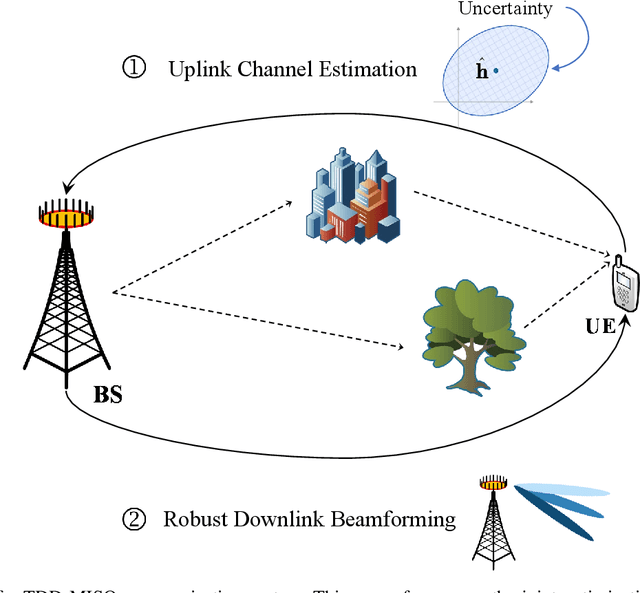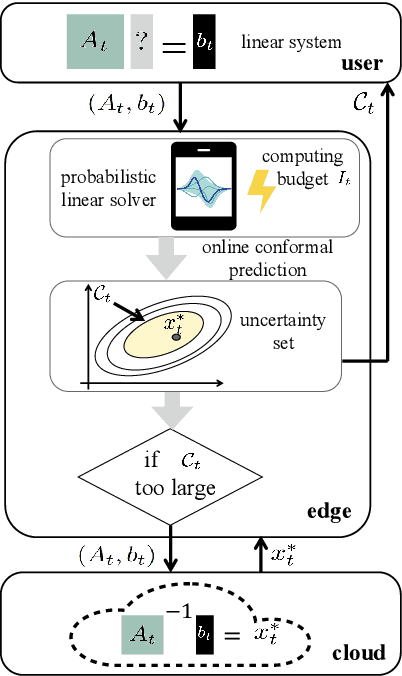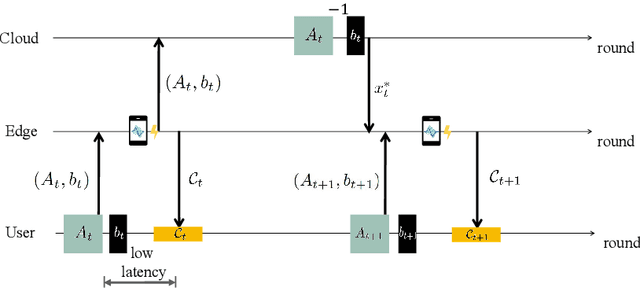Qiushuo Hou
Reliable LLM-Based Edge-Cloud-Expert Cascades for Telecom Knowledge Systems
Dec 23, 2025Abstract:Large language models (LLMs) are emerging as key enablers of automation in domains such as telecommunications, assisting with tasks including troubleshooting, standards interpretation, and network optimization. However, their deployment in practice must balance inference cost, latency, and reliability. In this work, we study an edge-cloud-expert cascaded LLM-based knowledge system that supports decision-making through a question-and-answer pipeline. In it, an efficient edge model handles routine queries, a more capable cloud model addresses complex cases, and human experts are involved only when necessary. We define a misalignment-cost constrained optimization problem, aiming to minimize average processing cost, while guaranteeing alignment of automated answers with expert judgments. We propose a statistically rigorous threshold selection method based on multiple hypothesis testing (MHT) for a query processing mechanism based on knowledge and confidence tests. The approach provides finite-sample guarantees on misalignment risk. Experiments on the TeleQnA dataset -- a telecom-specific benchmark -- demonstrate that the proposed method achieves superior cost-efficiency compared to conventional cascaded baselines, while ensuring reliability at prescribed confidence levels.
Conformal Robust Beamforming via Generative Channel Models
Apr 09, 2025



Abstract:Traditional approaches to outage-constrained beamforming optimization rely on statistical assumptions about channel distributions and estimation errors. However, the resulting outage probability guarantees are only valid when these assumptions accurately reflect reality. This paper tackles the fundamental challenge of providing outage probability guarantees that remain robust regardless of specific channel or estimation error models. To achieve this, we propose a two-stage framework: (i) construction of a channel uncertainty set using a generative channel model combined with conformal prediction, and (ii) robust beamforming via the solution of a min-max optimization problem. The proposed method separates the modeling and optimization tasks, enabling principled uncertainty quantification and robust decision-making. Simulation results confirm the effectiveness and reliability of the framework in achieving model-agnostic outage guarantees.
Online Conformal Probabilistic Numerics via Adaptive Edge-Cloud Offloading
Mar 18, 2025



Abstract:Consider an edge computing setting in which a user submits queries for the solution of a linear system to an edge processor, which is subject to time-varying computing availability. The edge processor applies a probabilistic linear solver (PLS) so as to be able to respond to the user's query within the allotted time and computing budget. Feedback to the user is in the form of an uncertainty set. Due to model misspecification, the uncertainty set obtained via a direct application of PLS does not come with coverage guarantees with respect to the true solution of the linear system. This work introduces a new method to calibrate the uncertainty sets produced by PLS with the aim of guaranteeing long-term coverage requirements. The proposed method, referred to as online conformal prediction-PLS (OCP-PLS), assumes sporadic feedback from cloud to edge. This enables the online calibration of uncertainty thresholds via online conformal prediction (OCP), an online optimization method previously studied in the context of prediction models. The validity of OCP-PLS is verified via experiments that bring insights into trade-offs between coverage, prediction set size, and cloud usage.
Automatic AI Model Selection for Wireless Systems: Online Learning via Digital Twinning
Jun 22, 2024



Abstract:In modern wireless network architectures, such as O-RAN, artificial intelligence (AI)-based applications are deployed at intelligent controllers to carry out functionalities like scheduling or power control. The AI "apps" are selected on the basis of contextual information such as network conditions, topology, traffic statistics, and design goals. The mapping between context and AI model parameters is ideally done in a zero-shot fashion via an automatic model selection (AMS) mapping that leverages only contextual information without requiring any current data. This paper introduces a general methodology for the online optimization of AMS mappings. Optimizing an AMS mapping is challenging, as it requires exposure to data collected from many different contexts. Therefore, if carried out online, this initial optimization phase would be extremely time consuming. A possible solution is to leverage a digital twin of the physical system to generate synthetic data from multiple simulated contexts. However, given that the simulator at the digital twin is imperfect, a direct use of simulated data for the optimization of the AMS mapping would yield poor performance when tested in the real system. This paper proposes a novel method for the online optimization of AMS mapping that corrects for the bias of the simulator by means of limited real data collected from the physical system. Experimental results for a graph neural network-based power control app demonstrate the significant advantages of the proposed approach.
Meta-Gating Framework for Fast and Continuous Resource Optimization in Dynamic Wireless Environments
Jun 23, 2023



Abstract:With the great success of deep learning (DL) in image classification, speech recognition, and other fields, more and more studies have applied various neural networks (NNs) to wireless resource allocation. Generally speaking, these artificial intelligent (AI) models are trained under some special learning hypotheses, especially that the statistics of the training data are static during the training stage. However, the distribution of channel state information (CSI) is constantly changing in the real-world wireless communication environment. Therefore, it is essential to study effective dynamic DL technologies to solve wireless resource allocation problems. In this paper, we propose a novel framework, named meta-gating, for solving resource allocation problems in an episodically dynamic wireless environment, where the CSI distribution changes over periods and remains constant within each period. The proposed framework, consisting of an inner network and an outer network, aims to adapt to the dynamic wireless environment by achieving three important goals, i.e., seamlessness, quickness and continuity. Specifically, for the former two goals, we propose a training method by combining a model-agnostic meta-learning (MAML) algorithm with an unsupervised learning mechanism. With this training method, the inner network is able to fast adapt to different channel distributions because of the good initialization. As for the goal of continuity, the outer network can learn to evaluate the importance of inner network's parameters under different CSI distributions, and then decide which subset of the inner network should be activated through the gating operation. Additionally, we theoretically analyze the performance of the proposed meta-gating framework.
 Add to Chrome
Add to Chrome Add to Firefox
Add to Firefox Add to Edge
Add to Edge